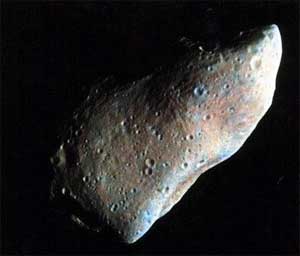An asteroid runs into Earth
Astronomers have just suggested that an asteroid might collide with Earth in 2102. However, this risk may be reduced when further studies are conducted.

The 191-asteroid 951 Gaspra was the first asteroid to be observed by the Galileo spacecraft on October 29, 1991.
2004 VD7 was first detected by Massachusetts Institute of Technology experts. New observations have helped the researcher more accurately calculate its trajectory. Specifically, 2004 VD4 has the potential to collide with the Earth on 4/5/2102.
Estimated 2004 VD17 has a diameter of about 580m. Such an asteroid would create an impact crater about 10km wide and an earthquake of 7.4 on the Richter scale if it plunged into the mainland. According to Don Yeomans, NASA's near-Earth Object Program Manager, the risk of collision of 2004 VD7 is ranked at level 2 on the Torino scale.
The Torino scale, adopted in 1999, is similar to a Richter scale for collisions between Earth and asteroids. Level 1 (blue) suggests collisions, close monitoring. Overcoming level 1, the risk continues to increase. Acts 2,3,4 are yellow. 7 orange and hiccup 8,9,10 red.
In December 2004, the Apophis asteroid was ranked at level 4 - the highest level an asteroid has achieved so far. However, the calculations later lowered the risk to level 1. Therefore, VD17 is currently in the first place in the list of potential collisions of NASA.
Yeomans said the 2004 VD17 collision risk was 1 / 1,600 in 2102 and 1 / 500,000 two years later. However, subsequent observations will calculate the trajectory more accurately and hopefully the risk of collision will be 0.
According to the hunters of the planet near Earth Andrea Milani Comparetti (University of Pisa, Italy), 2004 VD17 is a serious problem, but not for our generation. VD17 is very fuzzy in the distance, so it will need strong telescopes to see before it arrives.
Since 1998, NASA has been commissioned by the US Congress to identify 90% of the total planets close to Earth with a diameter of 1 km or more. This task must be completed in 2008.
So far NASA has identified 830 of about 1,100 such asteroids, along with thousands of smaller objects.
According to the Law of Delegation for NASA issued in 2005, Congress asked NASA to research and inform the best and most effective way to determine 90% of asteroids with a minimum diameter of 140m. According to Yeomans, there are about 100,000 such asteroids.
Minh Son
- The asteroid is about to fly closest to Earth in 115 years
- A 2,000-meter asteroid could crash into Earth in the future
- This afternoon, an asteroid will fly over the Earth
- Asteroid 800,000km2 fly near the Earth
- An asteroid has just crossed the Earth
- 2012 Asteroid BX34 almost collided with the Earth
- The biggest asteroid in the year is rushing towards Earth
- Video: The 7m asteroid is about to rush through the Earth
- The terrifying asteroid is about to hover near Earth
- NASA panicked because the giant rock was about to graze the Earth
- Asteroids have 'flattened' over Earth
- New discoveries about Ryugu asteroid near Earth
 Van Allen's belt and evidence that the Apollo 11 mission to the Moon was myth
Van Allen's belt and evidence that the Apollo 11 mission to the Moon was myth The levels of civilization in the universe (Kardashev scale)
The levels of civilization in the universe (Kardashev scale) Today Mars, the sun and the Earth are aligned
Today Mars, the sun and the Earth are aligned The Amazon owner announced a secret plan to build a space base for thousands of people
The Amazon owner announced a secret plan to build a space base for thousands of people